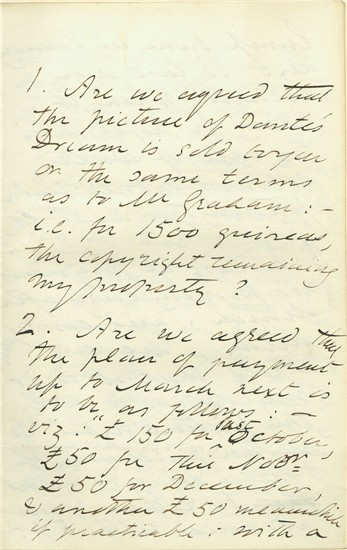
Dante's Dream at the Walker Art Gallery, NML
Dante’s Dream (1871) has resided at the Walker Art Gallery, National Museums Liverpool, since 1881, when the institution purchased the painting directly from Dante Gabriel Rossetti for £1575. The museum was not the first owner of this massive, stunning example of Pre-Raphaelite work, however. A single item from the Morgan’s collection of Rossetti letters figures into its interesting (read: frustrating) exchange of hands and underlines the turbulent nature of the art business. This recurrent theme, along with his inability to separate himself from the drama and gossip of the art world, undoubtedly contributed to Rossetti’s declining mental state and drug addiction throughout the last decade of his life.
The first owner of Dante’s Dream was William Graham, a Scottish politician and frequent patron of Pre-Raphaelite art, particularly that of Sir Edward Burne-Jones. Beginning in 1873, Rossetti’s correspondence with business agent (the infamous blackmailer) Charles Augustus Howell alludes to Graham’s desire to exchange the apparently cumbersome piece for a smaller replica.1 As an aside, Howell is perhaps best known for convincing Rossetti to have his own wife’s grave exhumed in the fall of 1869 to retrieve some “marketable” poetry he had buried with her, and Rossetti doesn’t seem to have caught wind of his questionable reputation until late 1874, as a letter to Ford Madox Brown suggests.2 At any rate, Rossetti agreed to Graham’s proposal and Howell located a second buyer for Dante’s Dream, Leonard Rowe Valpy, another frequent patron of the Pre-Raphaelites. In November of 1874, after months of deliberation, Rossetti and Valpy entered into an agreement, as documented by this draft (first leaf shown), probably a copy retained by Rossetti, of the terms of the sale.

MA 382.59
In 1878, Rossetti was horrified to learn that Valpy was retiring to his remote country home and that Dante’s Dream would join him there (if it fit), where hardly a soul would see it. In a letter to Valpy, Rossetti wrote:
“The only other large work I ever produced forms the reredos of Llandaff Cathedral, & both these works (in such case as you suggest) wd be equally unavailable to serve my reputation as an artist. It would be most desirable to me that the Dante, instead of being thus secluded from sight, should be somewhere seen by many.”3
Rossetti proposed an exchange that eventually left Valpy with several paintings of which the combined value was considerably higher than that of the original purchase, thus taking a loss for the sake of his vanity. Dante’s Dream then remained with Rossetti until purchased for the Walker Art Gallery in 1881.
For more information on the collection item, click here.
1 See William E. Fredeman, ed. The correspondence of Dante Gabriel Rossetti (Cambridge: D. S. Brewer, 2006), v. 6, particularly letters from Rossetti to Charles Augustus Howell and Leonard Rowe Valpy between 1873-1874, for numerous allusions to the transactions with both Graham and Valpy.
2 Fredeman, v. 6, no. 74.192, p. 528.
3 Ibid, v. 8, no. 78.178, p. 143.
The Leon Levy Foundation is generously underwriting a major project to upgrade catalog records for the Morgan's collection of literary and historical manuscripts. The project is the most substantive effort to date to improve primary research information on a portion of this large and highly important collection.
